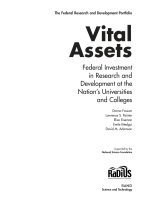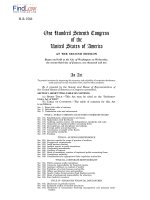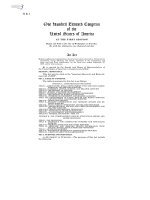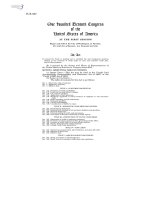3 1 3 maggie mcgee and me at the mint
Bạn đang xem bản rút gọn của tài liệu. Xem và tải ngay bản đầy đủ của tài liệu tại đây (3.22 MB, 12 trang )
Suggested levels for Guided Reading, DRA,™
Lexile,® and Reading Recovery™ are provided
in the Pearson Scott Foresman Leveling Guide.
by Susan Jones Leeming
illustrated by Daniel L. Grant
Genre
Realistic
fiction
Comprehension
Skills and Strategy
• Sequence
• Setting
• Visualize
Scott Foresman Reading Street 3.1.3
ISBN 0-328-13330-2
ì<(sk$m)=bd dah< +^-Ä-U-Ä-U
Reader Response
1. Skim the story to list the order in which
Maggie and Chris answered the ten
contest questions.
2. How is the U.S. Mint building described on
Susan
Jones any
Leeming
page 5? Canbyyou
visualize
buildings
you know of
that look
similarL.to
the mint?
illustrated
by Daniel
Grant
3. On a chart like the one below, list any
words from the story that are new to
you. Next, use context clues to write your
own definitions. Last, write the dictionary
definitions and compare.
New Word
My Definition
Dictionary
4. If you took a tour of the U.S. Mint, what
questions would you have that are
different from the ones in the story?
Editorial Offices: Glenview, Illinois • Parsippany, New Jersey • New York, New York
Sales Offices: Needham, Massachusetts • Duluth, Georgia • Glenview, Illinois
Coppell, Texas • Ontario, California • Mesa, Arizona
Every effort has been made to secure permission and provide appropriate credit for
photographic material. The publisher deeply regrets any omission and pledges to
correct errors called to its attention in subsequent editions.
Unless otherwise acknowledged, all photographs are the property of Scott Foresman,
a division of Pearson Education.
Photo locators denoted as follows: Top (T), Center (C), Bottom (B), Left (L), Right (R),
Background (Bkgd)
Illustrations by Daniel L. Grant
Photograph 20 Comstock Royalty Free
ISBN: 0-328-13330-2
Copyright © Pearson Education, Inc.
All Rights Reserved. Printed in the United States of America. This publication is
protected by Copyright, and permission should be obtained from the publisher
prior to any prohibited reproduction, storage in a retrieval system, or transmission
in any form by any means, electronic, mechanical, photocopying, recording, or
likewise. For information regarding permission(s), write to: Permissions Department,
Scott Foresman, 1900 East Lake Avenue, Glenview, Illinois 60025.
2 3 4 5 6 7 8 9 10 V0G1 14 13 12 11 10 09 08 07 06 05
Hi! My name is Chris Chen, and this is
a photo of my best friend, Maggie McGee,
and me. We are standing outside the United
States Mint in Philadelphia. The photo was
taken just after we won the class contest.
Do you know Maggie McGee? If you do,
then you won’t be surprised to hear that
she turned our third-grade class field trip
into a contest.
On the other hand, you might not know
Maggie McGee. If you don’t, then let me tell
you about the smartest, strongest, funniest
kid ever to attend Browning Elementary
School!
3
Maggie and I became friends on the day she
challenged and beat the bully Johnnie Jaspers
in a battle of the minds. Maggie recited the fifty
states and their capitals in alphabetical order.
Unfortunately for Johnnie, he could not even
remember the capital of Pennsylvania, the state
where we live! (It’s Harrisburg.)
Johnnie had been giving me a tough time
before Maggie had beaten him in the battle of
the minds. But afterward, he troubled me no
more! Even better, after Maggie won she told
me, “Stick with me, kid, and we’ll do fine.” And
that’s just what I did.
4
Our class went to the Philadelphia Mint,
where that photo I showed you was taken, at
the end of third grade. On the day of the field
trip, we boarded a bus. The ride to Philadelphia
didn’t take long and soon we were standing
outside the mint. It was enormous!
The mint was built of white stone. It had
sharp corners, dozens of tiny windows, and
bright white walls. The entire class was excited
to see the mint. Maggie and I were especially
excited. We’d been looking forward to the field
trip for months!
5
“This way class,” Ms. Chesterfield’s clear
voice instructed. “Here are your question
sheets.” Our class had brainstormed a list of
questions we wanted answered about the mint.
“Let’s have a contest,” Maggie suggested.
“Whoever answers the most questions on the
list wins.”
“That sounds like a wonderful idea, Maggie.
Class, please pick a partner and form teams of
two,” said Ms. Chesterfield.
Maggie and I decided right then to be
partners. I was happy to be on Maggie’s team.
With our combined abilities, I was sure we
could win the contest!
6
Inside the mint, Ms. Chesterfield reviewed
the list of questions that our class had put
together. “Question 1: What coins does this U.S.
Mint make? Questions 2 and 3: Which men and
women are on the coins? Question 4: Why is one
side of the coin called the ‘flip side?’ Question 5:
Why are there grooves on the edges of some
coins but not on others?”
Ms. Chesterfield continued to read from the
long list. “Question 6: What jobs do people do
at the mint? Question 7: Name a coin that’s no
longer in use.
“And finally: Choose any coin and respond
to the last three questions. Question 8: Explain
the history of the coin. Question 9: Explain
what the images on the coin mean. And
Question 10: Tell any interesting facts about
the coin you chose.”
7
How can we answer all those questions
in just two hours? I wondered. Then I
realized that if anyone could answer the
questions, it would be Maggie McGee. I
sighed and adjusted my backpack, waiting
for the fun to start.
A man in a blue uniform came out
and greeted our class. “I’m Walter Jones,
one of the mint’s police officers. I will be
taking you through the metal detectors
and into the mint, where you will meet
your tour guide, Ms. Smith.” Glancing
over the class, he added, “Please remember
that this is one of the most heavily guarded
places in the world. If you pay close
attention, you’ll learn many things today!”
On the other side of the metal detectors
was a huge lobby. Its walls displayed coin
exhibits. Maggie dragged me over to an exhibit
called The History of the Philadelphia Mint.
“C’mon,” she whispered. “This looks good.”
“What?” I asked.
8
“This mint produces all the U.S. coins used
today,” Maggie explained. “Quick, turn around,”
she directed. “I need to use your back to write
this all down. This mint makes pennies, nickels,
dimes, quarters, and half and whole dollars,”
Maggie continued. “We’ve just answered
question number one, and it only took us a few
minutes!”
9
In the next room we stood behind thick
plate-glass windows, staring at the huge
machines cranking away one story below
us. “We now use the most modern,
computer-automated machines,” our
tour guide, Ms. Smith, explained. “And
we still print the backside of every
coin upside down,‘the flip side,’ as
it is called.” Maggie nudged me and
began writing, leaning her paper
against the window. “That’s the
answer to question number four,”
Maggie whispered.
Ms. Smith continued,
“Quarters, fifty-cent pieces, and
dollars are no longer made from
precious metals. However, we
continue to print them with
grooved edges. The edges help
the visually impaired distinguish
one coin from another.” We’d
been told the answer to question
number five!
Maggie winked at me and
whispered, “Only seven more
to go!”
10
11
The next room had panels with large
replicas of the coins and their histories. “Let’s
write about the quarter for questions eight
through ten,” said Maggie. “You read about the
images, and I’ll read about the history.”
“OK,” I agreed. I was already reading about
how the image of the eagle on American coins
had changed over time. I laughed as I studied
the original image of the eagle. It looked more
like a pigeon than a majestic bird of prey!
“Don’t forget to write down what you
read,” Maggie instructed.
“Right,” I said, recording the image of
the pigeon-like eagle.
“Wow, the quarter was first minted in
1796. It was made heavier in 1873, and
it changed from silver to a mixture of
copper and nickel in 1965,” Maggie said.
She continued to fill in answers to the
questions at a furious pace.
“I’d like to have a real silver coin!” I
said as I imagined how shiny it would be.
12
“Yeah,” Maggie said, looking around the
room. “Hey,” she exclaimed suddenly. “If we
read the captions under each coin we’ll know
the answers to two and three. Remember,
Chris? Those are the questions about the men
and women on the coins!”
13
I dashed after Maggie as she told me about
the people on the coins.
“The image on the dime is of Franklin D.
Roosevelt. He was president of the United
States and got us through the Great
Depression. The nickel shows Thomas
Jefferson. He, too, was president, and helped
write the Declaration of Independence. And
the penny displays Abraham Lincoln. As
president, he led us through the Civil War.”
“Sacagawea is on the golden dollar coin,”
I said. “She helped Lewis and Clark explore
the West and communicate with Native
Americans!”
14
Maggie crossed her arms and smiled when
I finally caught up and finished filling in the
answers. “You know what this means, don’t
you?” Maggie whispered as we followed the
class out of the room. “We’ve now answered
every question except six and seven!”
“Great,” I replied. “But we only have half an
hour left, and we have to eat lunch,” I said.
Just then Ms. Smith said, “This way to the
cafeteria. The cooks have prepared a lunch
for the class.” The tour guide barely finished
her sentence before many of the student
groups cornered her and began badgering
her with questions.
15
I followed the rest of the class into the
cafeteria, and I picked up my lunch. Then I
attempted to find Maggie. I’d completely
lost her in the rush to get lunch!
I found Maggie sitting at a table.
“Where have you been?” she asked.
“We can answer question six by
sitting right here!”
I groaned. “We’re not going to
work on the contest here, are we?”
“Just look, Chris, at that guy
sitting one table over. He’s looking
at a sketch,” Maggie said. “I bet he
engraves the images on the coins.
He’s probably working on the
state quarter project right now!”
she whispered excitedly.
I looked over at the table next
to us with new interest. “You’re
probably right,” I agreed. “I wish
we had time to speak with him.”
16
17
“So there are engravers, tour guides,
mint police, cafeteria workers, cleaners, and
minters,” Maggie announced to me. “Now,
for the last question, number seven . . .”
Before Maggie could finish, our teacher, Ms.
Chesterfield, made an announcement.
“Finish up, class. We’ll be leaving the mint
in a few minutes.”
“May we stop in the gift shop before we
go?” Maggie asked anxiously.
“Well, I suppose so.” Ms. Chesterfield
studied her watch. “It’s on the way out.”
18
I couldn’t find any answers to question
seven inside the gift shop so I left. When
Maggie came out, I apologized to her. “I’m
sorry we didn’t win,” I said.
“What are you talking about?” she replied.
“We were the only group to get the answers to
all ten questions!”
“Huh? But I thought . . . ” I stammered.
Maggie explained. “I knew the gift shop
would be selling old coins for collectors.”
Maggie showed me a coin and explained, “This
two-cent piece is just a replica. The real coin is
worth a lot more than two cents now.”
“Wow! You really are the greatest,” I said,
amazed. And that’s how our field trip ended.
19
Budgeting Your Money
Budgets help people keep track of how
much money they have, how they spend it, and
how much they save.
Some people may use a computer program
or a special notebook to help them organize
their budget. In order to keep track of how
much they are spending and saving, people
often save their receipts and balance their
checkbooks. If they have spent more in one
area than their budget allows, they may decide
to use less money in another area.
Does your family use a budget? What about
you? How do you think a budget might help
you take care of your money?
Reader Response
1. Skim the story to list the order in which
Maggie and Chris answered the ten
contest questions.
2. How is the U.S. Mint building described on
page 5? Can you visualize any buildings
you know of that look similar to the mint?
3. On a chart like the one below, list any
words from the story that are new to
you. Next, use context clues to write your
own definitions. Last, write the dictionary
definitions and compare.
New Word
My Definition
Dictionary
4. If you took a tour of the U.S. Mint, what
questions would you have that are
different from the ones in the story?
20









